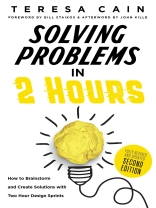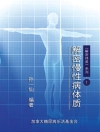Solving Problems in 2 Hours: How to Brainstorm and Create Solutions with Two Hour Design Sprints is an award-winning New Release and Best Seller in Business Technology Innovation for entrepreneurs, product managers, researchers, designers, startup founders and business professionals who want to accelerate business strategy and innovation with critical problem solving in two hours.
Teresa Cain not only provides a detailed approach for how you can solve critical business problems with two hour design sprints using Figma Fig Jam, she also shares her own insights with 15+ years experience in product and UX on popular concepts including Don Norman’s The Design of Everyday Things, Tom Wujec’s problem solving sketch concept Draw How to Make Toast in Three Minutes, Nielsen Norman Group’s prediction on UX growth through the year 2050 – to the wide variance of UX budgets at tech organizations, impact of remote work, shift to new a generation of users – from Boomers, Gen X to Millenials, Gen Z, and the impact of Chat GPT to UX and user personas.
Many organizations have based their own design thinking process from Stanford’s design thinking model or using Google Ventures and Jake Knapp’s five day process from the book Sprint: How to Solve Big Problems and Test New Ideas in Just Five Days. However, five day design sprints have had its challenges during the COVID-19 pandemic including the ability to conduct a remote design sprint using the same process effectively, loss of productive time and the ability to collaborate with multiple stakeholders in one room.
The adaptation to two hour design sprints helps organizations increase the frequency and speed of solving small and medium problems whether virtual or in-person, while still using the five day design sprint method to solve larger problems. Teresa Cain spent over three years teaching, testing and implementing this concept at organizations and conferences around the world, including launching the highest rated and best selling Udemy on-demand training course on design sprints, 2 Hour Design Sprint: Learn how to solve problems and design products in just 2 hours vs. 5 days using Figma Fig Jam and received a prestigious Emerging Scholar Award in 2023 from the International Conference on Design Principles and Practices, presenting on my research Putting into Practice Evolving Design Thinking Methods at Technology Firms: The Evolution to 2 Hour Design Sprints.
Two hour design sprints can help teams deliver value driven features to clients faster by simplifying traditional methods. Save your organization thousands of dollars and get ahead of competitors by learning how to brainstorm and create solutions faster for your business.
Table des matières
Foreword by Bill Staikos
The Importance of Design Sprints
Design Sprints in Action
Benefits We Can Achieve Through Design Sprints
Compressing Design Sprints to 2 Hours from 5 Days
Introduction
Tactical Value You Will Get Out of This Book
Chapter 1: What are Two Hour Design Sprints?
Inspired by Design Thinking and Design Sprint Methods
Evolution of the Design Sprint
Creator of the Design Sprint Process Jake Knapp and Google Ventures
Benefits of Two Hour Design Sprints
Chapter 2: Five Day Design Sprints
Five Day Design Sprint Schedule
Chapter 3: Impact of Remote Work on Design Sprints
Solving Big Problems with No Budget
Technology Replaces In-Person Collaboration
Chapter 4: Two Hour Design Sprint Schedule
During the Two Hour Design Sprint
Condensing a Five Day Design Sprint
After the Two Hour Design Sprint
Exercise: Problem Exploration
Chapter 5: Stage 1 Empathize with Customers
Chapter 6: Stage 2 Explore the Problem
Chapter 7: Use Chat GPT to Create a Problem Statement, Goal and User Personas
Exercise: Create a Problem Statement and Goal Using Chat GPT
Chapter 8: Stage 3 Ideate Solutions
Chapter 9: Stage 4 & 5 Prototype and Test
Exercise: Create a User Persona
Chapter 10: Additional Prep for a Successful Two Hour Design Sprint
Create Stakeholder List
Review Fig Jam Whiteboard
Finalize Agenda and Use Timer
Utilize Parking Lot
Practice Run
Design Sprint Rules
Send Fig Jam Link to Participants
Virtual or In-Person
Chapter 11: Conduct Your Two Hour Design Sprint
Mock Design Sprint
Two Hour Design Sprint Template on Fig Jam
Problem Statement & Goals User Personas
Exercise: Setup Your Fig Jam Collaborative Whiteboard
Chapter 12: Advantages of Using Two Hour Design Sprints
Time Savings – It’s Only Two Hours
Global Collaboration – Everyone Can Be 100% Remote
Less Setup Time – Replace Post-its with Virtual Sticky Notes
Anyone on the Team Can Be a Moderator – No Third Parties
Collaborative Whiteboard Tools for Remote Collaboration
Documentation and Design in One Location
Sketch Using any Tool
Virtual Voting on High Value Features
Multiple Design Sprints in a Week –
Implement Solutions Faster for Your Clients
Chapter 13: Final Recommendations
The Decider Role in Two Hour Design Sprints
Selling Two Hour Design Sprints to Your Organization
The Importance of Stakeholder Buy-In
Design Sprint to Backlog
Chapter 14: Solve Any Problem
For Startups or Small Organizations
Roadmap Growth for Entrepreneurs
Lack of Internal Stakeholders or Customers
For Large Organizations
When to Use Five Day versus Two Hour Design Sprints
Choosing a Problem
When to Use a Moderator or Third Party Consulting Firm
School, Home or Professional Settings
Books on Five Day Design Sprints
Other Two Hour Design Sprint Methods
Chapter 15: Two Hour Design Sprint Success Stories
Chapter 16: The rise of UX in Technology Organizations
2000-2010
2010-2020
The Future of UX
Afterword: The Importance of Discovery Research Before the Two Hour Design Sprint by John Kille
Why UX Research?
Methods of Understanding
Successful Design Sprint Prep
A propos de l’auteur
Teresa Cain is an award winning entrepreneur, educator, speaker and author. She is the Director of Product Management, User Experience and Design for Trevi Pay, a global Fin Tech organization. She is also the founder of Lucid Startup Consulting, a training firm focused on research, strategy, and vision for product managers, UX teams, businesses and entrepreneurs.With over 15 years experience in the field of product management, innovation and design thinking methods, she has accelerated roadmap growth and user adoption for dozens of Fortune 100 and 500 organizations, and start-ups into multi-million dollar growth. Teresa serves on the board for Dev Stride, a recently funded startup in agile project and portfolio management and strategy, and is on the corporate advisory board for Central Exchange, a nonprofit focused on providing opportunities for women around the globe.Teresa has led workshops and training for hundreds of high profile companies across the globe, and spoken at multiple conferences on product strategy and design thinking methods, including Product World, UXDX, Women in Product, UXPA and Developer Week and as a featured guest on the podcast, Be Customer Led. She has the highest rated course on Udemy for design sprints 2 Hour Design Sprints: Learn How to Design and Execute a Simplified Approach to Solving Problems Faster.Teresa has an Executive Master in Business Administration from Rockhurst University and is finishing a Master of Integrated Innovation for Products & Services at Carnegie Mellon University. She completed two undergraduate degrees, a Bachelor of Arts in English from the University of Kansas and a Bachelor of Science in Journalism from the William Allen White School of Journalism, as well an Executive Education program on Product Strategy at Northwestern University.Teresa has completed many certifications during her career in product, customer experience, agile, project management and process management including Pragmatic Marketing Certified III ©, Net Promoter Certified Associate, Certified Scrum Product Owner, Certified Scrum Master, Project Management Professional and Lean Six Sigma Green Belt.Teresa was a 2022 Women in IT Summit & Award Series Finalist for Advocate of the Year and received a prestigious Emerging Scholar Award in 2023 from the International Conference on Design Principles and Practices including presenting on her research ‘Putting Into Practice Evolving Design Thinking Methods at Technology Firms: The Evolution To 2 Hour Design Sprints.’












